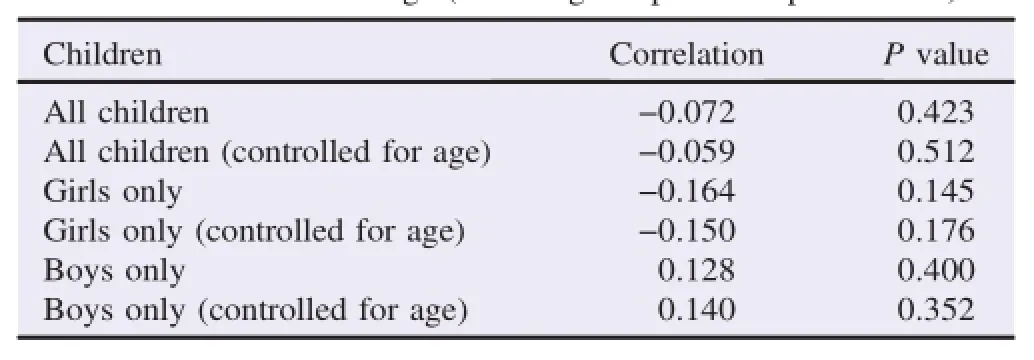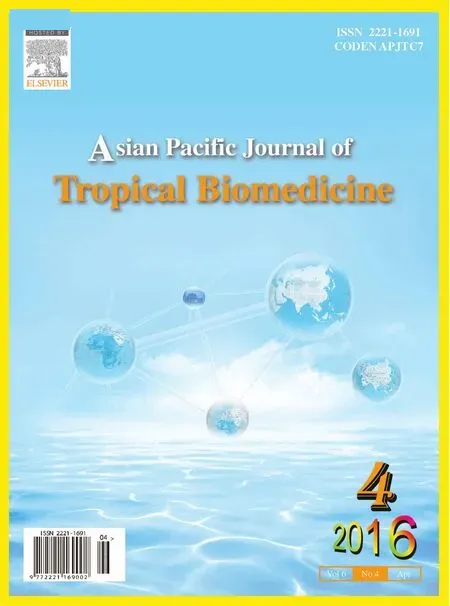Salivary leptin concentrations in Bruneian secondary school children
Adi Idris,Ahmed Gharib Kham is,Nur Basirah Ghazali,M ichael Steele,David Koh,,Nik Ani TuahPAPRSB Institute of Health Sciences,Universiti Brunei Darussalam,Brunei DarussalamFaculty of Science,Universiti Brunei Darussalam,BruneiDarussalamSaw Swee Hock School of Public Health,National University of Singapore,Singapore
Salivary leptin concentrations in Bruneian secondary school children
Adi Idris1*,Ahmed Gharib Kham is1,Nur Basirah Ghazali1,M ichael Steele2,David Koh1,3,Nik Ani Tuah11PAPRSB Institute of Health Sciences,Universiti Brunei Darussalam,Brunei Darussalam
2Faculty of Science,Universiti Brunei Darussalam,BruneiDarussalam
3Saw Swee Hock School of Public Health,National University of Singapore,Singapore
Original article http://dx.doi.org/10.1016/j.apjtb.2016.01.003
ARTICLE INFO
Article history:
Received in revised form 3Nov 2015 Accepted 22 Nov 2015
Availableonline8 Jan 2016
Obesity
Saliva
Leptin
Brunei
Adolescents
Body mass index
ABSTRACT
Ob jective:To investigate the association between leptin levels and body mass index in Bruneian secondary school students.
M ethods:The body mass index of Bruneian secondary school students(aged 11–18 years)was determ ined before collecting their saliva using the passive drool technique. Salivary leptin concentration was determ ined by ELISA.
Resu lts:Correlation and partial correlation(controlled for age)analyses showed no signi fi cant differences between the levels of salivary leptin of normalweight and overweight students.
Conclusions:No signi fi cant increase in the salivary leptin concentration wasobserved in overweight compared w ith normalweight Bruneian secondary school students.
1.Introduction
Obesity is a grow ing problem worldw ide and is associated w ith several health-related conditions,including cancer[1],and cardiovascular diseases[2].In Southeast Asia,the emerging problem of rising rates of childhood obesity is alarm ing[3].In Brunei,a 1995–1996 national survey showed a prevalence of obesity in males and females at 11.2%and 12.8%, respectively[4].However,the prevalence rates have increased over the past decade.A 2008 World Health Organisation report on body mass index(BM I)showed that Brunei had the highestobesity rate among Southeast Asia countries[5].
Leptin,important in lipidmetabolism,has been suggested to be a biomarker for obesity and abnormal metabolic pro fi le. Obesity is de fi ned as excessive grow th of adipose tissue[6].In humans,circulating leptin correlates w ith body weight and fat mass[7],and therefore,leptin is a good predictor for adiposity. The relationship between plasma leptin levels and body composition has been studied in adolescents from non-Southeast Asia[8]and Southeast Asia countries including M alaysia[9],Thailand[10]and the Philippines[11].In all these studies,a positive association between BM I and plasma leptin was observed.However,all these studies measured leptin in the blood plasma compartment.Saliva,on the other hand,has major advantages over peripheral blood for the study of obesity in children because sample collection is non-invasive and rapid.However,few investigations involving children have used saliva as amodel biological fl uid to measure leptin levels in obesity[12].
To date,there are no reports on leptin levels and obesity in the Bruneian population and secondary school students.Therefore,our study investigated the BM I and salivary leptin levels in Bruneian secondary school students.
2.M aterials and methods
2.1.Ethical approval
This project received ethical clearance from the PAPRSB Institute of Health Sciences,Universiti Brunei Darussalam Ethics Comm ittee.
2.2.Subjects
This study using the multi-stage cluster sampling method involved secondary schools in the Brunei-Muara District.The projected sample size was 374 students,butonly 169 secondary school students aged between 11 and 18 years agreed to participate in the study(45%response rate).Studentswereasked to fi ll in questionnaires,and anthropometricmeasurements(height and weight)were performed,and saliva sampleswere then collected. No physical exam ination was performed during data collection. School children were from fi ve secondary schools in the Brunei-Muara District,Brunei Darussalam.Consentwas obtained from all participants and their parents.According to theWorld Health Organisation criteria for5–19 years old children and adolescents, a BM I between 15 and 22 kg/m2was considered as normal weight.A BM Iof>21.5 kg/m2was considered asoverweight for girls,and BM Iof 15–21.5 kg/m2as normalweight.For boys,a BM I≥22 kg/m2was considered as overweight.The BMIwas calculated as weight(kg)divided by height squared(m2).Inclusion criteria of participants were students w ithout any noncommunicable diseases.Students were advised not to consume carbonated drinks 1 h prior to saliva collection.
2.3.Saliva collection
Saliva from participants was collected by trained research personnel using the passive drool technique as described in the guidelines for Salimetricssaliva collectionmethods(Salimetrics, Carlsbad,CA,USA).Participantswere required to drool through a 15 m L sterile centrifuge tube to obtain a volume of approximately 1m L of saliva.Salivawas centrifuged at3000 r/min for 15m in before storing at−80°C.
2.4.Salivary leptin concentrationmeasurement
Salivawas thawed at room temperature before the ELISA on salivary leptin was performed in duplicate for each sample.The concentration of salivary leptin(pg/m L)wasmeasured using a leptin ELISA kit(Ray Biotech,Inc.,Norcross GA,USA)according to themanufacturer's speci fi cations.
2.5.Statistical analysis
Comparison of salivary leptin concentration,BM I and age between Brunei secondary school males and females were conducted by t-test.Correlations between BM I and leptin concentrations were conducted for the various subgroups of students.Partialcorrelationswere also conducted to control forage. Data were analysed using IBM SPSS Version 20.0(SPSS Institute,Chicago,IL,USA).
3.Results
Out of the 169 school children saliva samples,40 were excluded from the analysis based on the poor percentage coeffi cient of variation(CV)(>10%).Another 34 samples were excluded because the salivary leptin measured was below the detection threshold(2 pg/m L).Therefore,a total of 95 student sampleswere selected for analysis,of which 37 were boys and 58 girls(Table1).Of theboys,54%(n=20)had BM Is≥22 kg/ m2(overweight),while 31%(n=18)of the girls had BM Is>21.5 kg/m2(overweight).Most of the students were native Malay ethnicity(>95%).No signi fi cant correlation was found between the levels of salivary leptin of normalweightand overweightchildren,irrespective of sex when controlled for age (Table 2 and Figure 1).Salivary leptin levels were found to be sim ilar between boys and girls(Figure 1B,C).To discount the possibility that the 40 samples initially excluded from the correlation analysis because of the poor%CV underestimated the data,we included these samples for analysis and found that the correlation between salivary leptin levels of normal and overweight individuals was not signi fi cant(Table 3).Overall,the data shown that there was no correlation between BM I and salivary leptin levels in the school children tested.

Table1 Characteristics of subjects selected for analysis.

Table2 Correlation analysis between BM Iand leptin concentration and partial correlations controlled for age(excluding sam plesw ith poor%CV).

Figure 1.No signi fi cant difference in the salivary leptin levels between normal and overweight school children was found.A:School children;B:Boys only;C:Girls only.Scatter p lots show the spread of the data between normal and overweight.The horizontal line represents themean and the error bars represent the SD.

Table3 Correlation analysis between BM Iand leptin concentration and partial correlations controlled for age(including sam plesw ith poor%CV).
4.Discussion
This is the fi rst study to investigate leptin concentrations in Bruneian school children by exam ining the association of BM I w ith leptin concentrations in the salivary compartment.Our results showed no signi fi cant correlation between salivary leptin levels of normal and overweight individuals(Table 2 and Figure 1).A lso,the salivary leptin levels between male and female studentswere not signi fi cantly different(Figure 1).It is known that salivary leptin and plasma leptin concentrations are signi fi cantly higher in females than males[13],suggesting that theremay be differential regulation of salivary leptin between males and females.However,Randeva et al.measured leptin in adults,not children[13].Therefore it is possible that salivary leptin levels between males and females vary between adults and children.
Saliva serves as a good source of potential disease biomarkers;given itsnon-invasiveand rapid collection process,it is less dif fi cult to collect saliva compared to peripheral blood especially in children.A lthough salivary leptin levels were reported to be much lower than plasma leptin levels,there is a strong correlation between salivary and plasma leptin for both adults(aged 22–38 years)[13]and adolescents(aged 11–18 years)[14].A lthough we did notmeasure blood plasma leptin levels in our study,previous fi ndings have shown a strong correlation between salivary and plasma leptin in adolescents [14],suggesting that salivary leptin values in our study could indeed re fl ect circulating blood leptin levels.Contrary to our fi ndings,Goodson et al.found that salivary leptin was three times higher in obese compared to healthy normal weight Kuwaiti children aged between 10 and 12 years[12].However, it is important to note that the saliva samples from this previous study were collected from children who were not ethnically from the Southeast Asia region[12].Ethnicity is an important factor to consider in our analysis.A previous investigation has shown that South Asian women and men had signi fi cantly higher blood plasma leptin concentrations than all other groups tested(European,Chinese and Aboriginals)[15]. A lthough this study measured plasma leptin levels in adults (aged 35–75 years),it is possible that the levels of salivary leptin in the Bruneian adolescents are different from those of non-Asian adolescents.
In conclusion,we found thatmale Bruneian secondary school studentsweremoreoverweight than the females.Ouranalysisof leptin levels in the saliva of the students showed no signi fi cant differencebetween normaland overweightchildren.A follow up study is needed to investigate the resting levels of salivary and plasma leptin in young boys and girls to understand the differential regulation of salivary leptin.
Con fl ict of interest statement
We declare thatwe have no con fl ict of interest.
Acknow ledgm ents
Thisprojectwasfunded by theBruneiResearch Council(Grant No.BRC4).Wewould like to acknow ledge the casual laboratory assistants under BRC4 who were involved in the logistics of the saliva collection.W ealso specially thank HeliVitala forassisting in the distribution of thequestionnaires to the participants.
References
[1]Ungefroren H,Gieseler F,Fliedner S,Lehnert H.Obesity and cancer.Horm Mol Biol Clin Investig 2015;21:5-15.
[2]Jokinen E.Obesity and cardiovascular disease.Minerva Pediatr 2015;67:25-32.
[3]Angkurawaranon C,JiraporncharoenW,Chenthanakij B,Doyle P, N itsch D.Urbanization and non-communicable disease in Southeast Asia:a review of currentevidence.Public Health 2014;128: 886-95.
[4]Ibrahim M,Roseyati Y.Brunei Darussalam:nutritional overview. Bandar Seri Begawa:Community Nutrition Division,M inistry of Health,BruneiDarussalam.1999.[Online]Available from:http:// www.wpro.who.int/nutrition/documents/docs/bru.pdf[Accessed on 6th October,2015]
[5]World Health Organization.Noncommunicable diseases country pro fi les 2014.Geneva:World Health Organization;2014.[Online] Available from:http://apps.who.int/iris/bitstream/10665/128038/1/ 9789241507509_eng.pdf?ua=1[Accessed on 6th October,2015]
[6]Fasshauer M,Bl¨uherM.Adipokines in health and disease.Trends Pharm Sci2015;36(7):461-70.
[7]S´ainz N,Barrenetxe J,Moreno-A liaga M J,Martínez JA.Leptin resistance and diet-induced obesity:central and peripheral actions of leptin.Metabolism 2015;64:35-46.
[8]A rgente J,Barrios V,Chowen JA,Sinha MK,Considine RV. Leptin plasma levels in healthy Spanish children and adolescents, children w ith obesity,and adolescents w ith anorexia nervosa and bulimia nervosa.J Pediatr 1997;131:833-8.
[9]Fan SH,Say YH.Leptin and leptin receptorgenepolymorphismsand theirassociationw ithplasma leptin levelsand obesity inamulti-ethnic M alaysian suburban population.JPhysiol Anthropol2014;33:15.
[10]Tungtrongchitr R,Pongpaew P,Phonrat B,Tribunyatkul S, Viroonudomphol D,Supawan V,et al.Leptin concentration in relation to body mass index(BM I)and hematologicalmeasurements in Thai obese and overweight subjects.Southeast Asian J Trop Med Public Health 2000;31:784-94.
[11]Kuzawa CW,Quinn EA,Adair LS.Leptin in a lean population of Filipino adolescents.Am JPhys Anthropol 2007;132:642-9.
[12]Goodson JM,Kantarci A,Hartman ML,Denis GV,Stephens D, Hasturk H,et al.Metabolic disease risk in children by salivary biomarker analysis.PLoSOne 2014;9(6):e98799.
[13]Randeva HS,Karteris E,Lewandow ski KC,Sailesh S,O'Hare P, Hillhouse EW.Circadian rhythmicity of salivary leptin in healthy subjects.Mol Genet Metab 2003;78:229-35.
[14]Aydin S,Halifeoglu I,Ozercan IH,Erman F,Kilic N,Aydin S, etal.A comparison of leptin and ghrelin levelsin plasma and saliva of young healthy subjects.Peptides 2005;26:647-52.
[15]Mente A,Razak F,Blankenberg S,Vuksan V,Davis AD,M iller R, et al.Ethnic variation in adiponectin and leptin levels and their association w ith adiposity and insulin resistance.Diabetes Care 2010;33:1629-34.
23 Oct 2015
*Corresponding author:Adi Idris,PAPRSB Institute of Health Sciences,UniversitiBrunei Darussalam,Jalan Tungku Link Gadong,BE1410,Brunei Darussalam.
Tel:+6738987060
E-mail:yusri.idris@ubd.edu.bn
The study protocol was performed according to the Helsinki declaration and approved by the PAPRSB Institute of Health Sciences,Universiti BruneiDarussalam Ethics Comm ittee.Informed w ritten consent was obtained from all participants and their parents.
Peer review under responsibility of Hainan M edical University.The journal implements double-blind peer review practiced by specially invited international editorial board members.
Foundation Project:Supported by the Brunei Research Council(Grant No. BRC4).
2221-1691/Copyright©2016 Hainan Medical University.Production and hosting by Elsevier B.V.This is an open accessarticle under the CC BY-NC-ND license(http:// creativecommons.org/licenses/by-nc-nd/4.0/).
 Asian Pacific Journal of Tropical Biomedicine2016年4期
Asian Pacific Journal of Tropical Biomedicine2016年4期
- Asian Pacific Journal of Tropical Biomedicine的其它文章
- Sudden death in a captive mee rkat(Suricata surica tta)w ith arterial m edial and m yocardial calcification
- Characteristics o f obese or overweight dogs visiting private Japanese vete rinary c linics
- Risk factors from HBV infection among blood donors:A system atic review
- Com putational in telligence in tropicalm edicine
- The African Moringa is to change the lives ofm illions in Ethiopia and far beyond
- Pediculosis capitis among p rimary and m idd le school children in Asadabad,Iran:An epidem iological study
